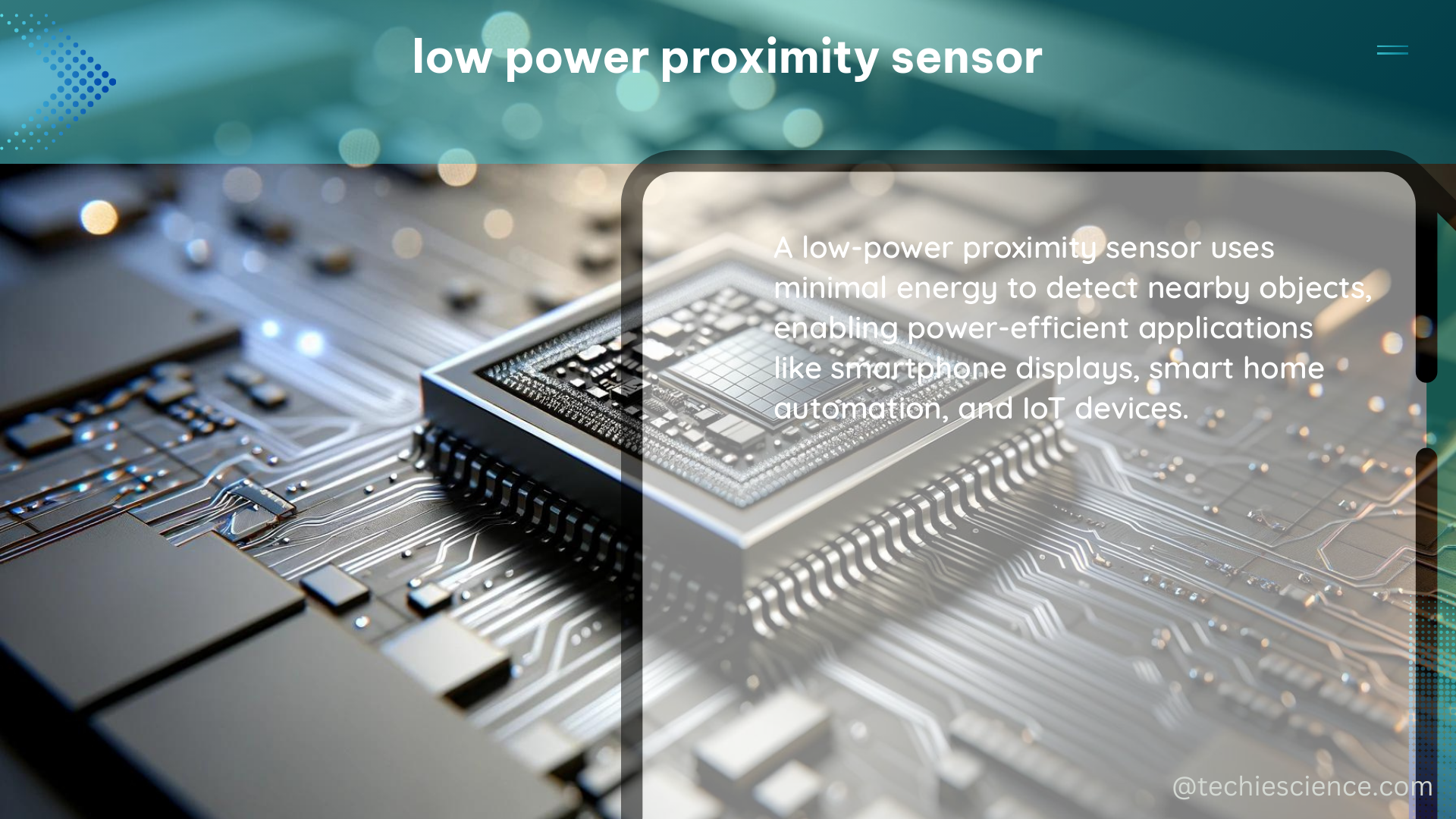Low power proximity sensors are essential components in various applications, including intrusion detection systems, robotics, and healthcare devices. These sensors consume minimal power, typically around 5 to 10 milliwatts, making them ideal for battery-powered or energy-constrained devices.
Understanding Capacitance-based Proximity Sensors
One of the most common types of low power proximity sensors is the capacitance sensor. These sensors measure changes in capacitance to detect nearby objects. The working principle of a capacitance-based proximity sensor is as follows:
- The sensor consists of a pair of conductive plates, forming a capacitor.
- When an object approaches the sensor, the object’s presence alters the electric field between the plates, changing the overall capacitance.
- This change in capacitance is detected by the sensor’s circuitry, which then triggers a response, such as activating an alarm or controlling a robotic system.
Capacitance-based proximity sensors can be installed in various configurations, such as under carpets, on walls, or near doors, to provide comprehensive coverage. They offer several advantages, including:
- Low power consumption: Typically around 5-10 milliwatts
- High sensitivity: Able to detect objects at distances up to several centimeters
- Robust design: Can withstand harsh environmental conditions
Dual-technology Proximity Sensors

Another type of low power proximity sensor is the dual-technology sensor, which combines passive infrared (PIR) and microwave sensors. This combination helps to minimize false alarms and improve the overall reliability of the sensor.
The working principle of a dual-technology proximity sensor is as follows:
- The PIR sensor detects changes in infrared radiation, which can be caused by the presence of a moving object, such as a person.
- The microwave sensor emits and detects changes in a microwave signal, which can also be affected by the presence of an object.
- The sensor’s circuitry analyzes the signals from both the PIR and microwave sensors to determine if a genuine intrusion has occurred, reducing the likelihood of false alarms.
Dual-technology proximity sensors offer the following benefits:
- Improved accuracy: The combination of PIR and microwave sensors enhances the sensor’s ability to detect and differentiate between genuine intrusions and false triggers.
- Low power consumption: Typically around 5-10 milliwatts, similar to capacitance-based sensors.
- Versatile installation: Can be mounted on walls, ceilings, or other surfaces to provide comprehensive coverage.
Integrating Proximity Sensors into Sensor Systems
Low power proximity sensors can be integrated into larger sensor systems, which typically consist of the following components:
- Sensors: The proximity sensors, along with other types of sensors, such as temperature, humidity, or gas sensors.
- Measuring and Processing Circuits: These circuits convert the sensor’s output signals into digital data that can be processed by a microcontroller or a computer.
- Output System: This component is responsible for displaying, storing, or transmitting the processed data, such as through a display, a wireless communication module, or a data storage device.
These sensor systems can be used to measure or detect a wide range of physical, chemical, and biological quantities, including:
- Proteins and bacteria
- Chemicals and gases
- Light intensity
- Motion and position
- Sound and vibration
- Human body-related applications
Quantifying Human States using Proximity Sensors
In the context of physical human-robot interaction (pHRI), low power proximity sensors can be used to quantify human states based on measurable data. This involves the following steps:
- Identifying Correlations: Researchers study the relationship between the sensor data and various human states, such as emotional, cognitive, or physical states.
- Developing Machine Learning Models: Machine learning algorithms are used to analyze the sensor data and establish predictive models that can estimate human states.
- Formulating Mathematical Models: Researchers develop mathematical models that describe the relationship between the sensor data and the human states, allowing for more accurate quantification.
It’s important to note that the correlations between sensor data and human states may not hold true in every application, and extensive empirical studies are required for validation and confirmation.
Technical Specifications and Performance Metrics
When selecting low power proximity sensors for your application, it’s important to consider the following technical specifications and performance metrics:
| Specification | Typical Range |
|---|---|
| Power Consumption | 5-10 milliwatts |
| Sensing Range | 1-50 cm |
| Sensing Accuracy | ±1-5 mm |
| Response Time | 10-100 milliseconds |
| Operating Temperature | -20°C to 70°C |
| Humidity Range | 0-95% RH |
These specifications can vary depending on the specific sensor model and manufacturer, so it’s essential to carefully review the datasheet and select the sensor that best fits your application requirements.
Conclusion
Low power proximity sensors offer a versatile and energy-efficient solution for a wide range of applications, from intrusion detection to robotics and healthcare. By understanding the working principles of capacitance-based and dual-technology sensors, as well as their integration into sensor systems and the quantification of human states, you can effectively leverage these technologies to enhance your projects and solutions.
References
- Biosensors and their widespread impact on human health
- NUREG-1959 “Intrusion Detection Systems and Subsystems
- Sensing and Sensor Fundamentals – SpringerLink
- Human Factors Considerations for Quantifiable Human States in Physical Human–Robot Interaction: A Literature Review

The lambdageeks.com Core SME Team is a group of experienced subject matter experts from diverse scientific and technical fields including Physics, Chemistry, Technology,Electronics & Electrical Engineering, Automotive, Mechanical Engineering. Our team collaborates to create high-quality, well-researched articles on a wide range of science and technology topics for the lambdageeks.com website.
All Our Senior SME are having more than 7 Years of experience in the respective fields . They are either Working Industry Professionals or assocaited With different Universities. Refer Our Authors Page to get to know About our Core SMEs.